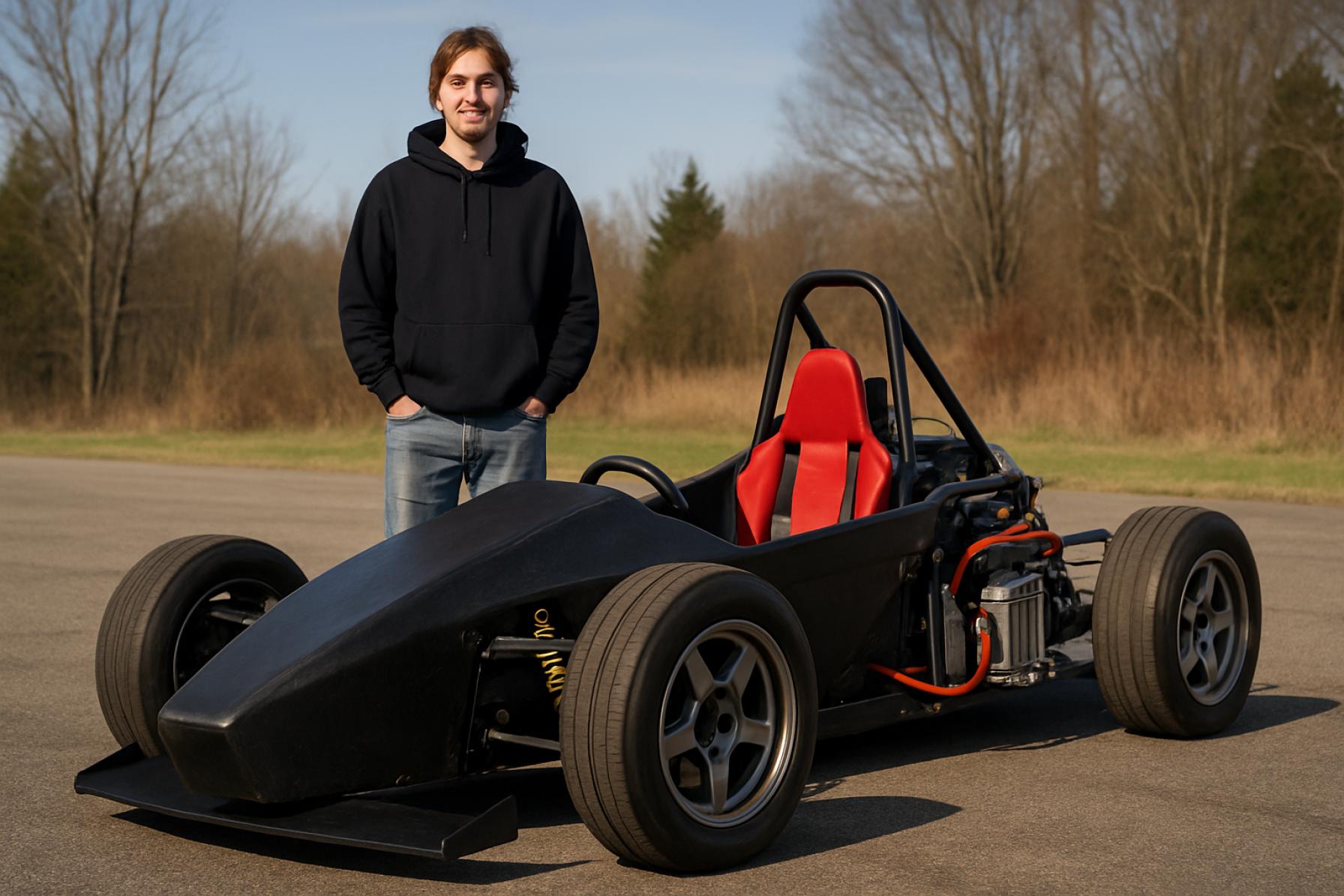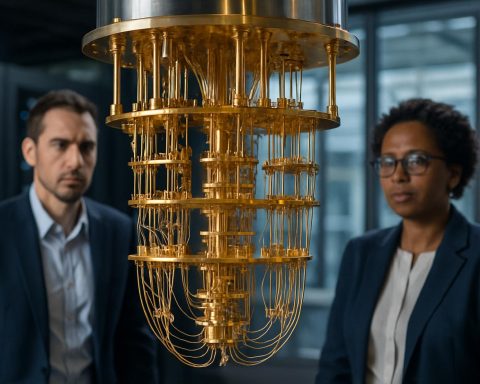- The Apex Cricket EV is a lightweight, electric autocross car inspired by the Ariel Atom, built by a father and son using salvaged parts and creative engineering.
- Powered by a Gen3 Nissan Leaf electric motor (214 hp) and a Chrysler Pacifica hybrid battery (16 kWh), it delivers impressive performance—up to 100 miles of range on a single charge.
- A unique six-speed manual transmission from a Nissan Maxima, combined with a limited-slip differential, helps manage electric torque for smoother racing dynamics.
- Robust suspension, steering, and brakes from a C5 Corvette blend electric technology with proven mechanical components, ensuring excellent handling.
- The entire project cost about $20,000, proving that high-performance electric racing can be accessible, reliable, and achievable through DIY passion and ingenuity.
Under the California sun, where innovation pulses from garages as much as from Silicon Valley labs, a father and son quietly unleashed a force of electric ingenuity onto the autocross circuit. Their creation—a vivid, Ariel Atom-inspired machine dubbed the Apex Cricket EV—roars not with gasoline, but with the hum of salvaged technology and sheer dedication.
- Lean, Green, and Lightning-Quick: Weighing just 1,700 pounds, the Apex Cricket EV embodies the essence of minimalism and efficiency. Its skeletal frame and open wheels slice through the air, while an emerald body flashes past orange cones at speeds that leave competitors stunned.
- Power Shared Across Generations: The heart of this homegrown racer beats with a Gen3 Nissan Leaf electric motor, producing a formidable 214 horsepower. This isn’t a pie-in-the-sky prototype or a multi-million-dollar concept—it’s the product of junkyard finds and family teamwork. Backing up the motor, a Chrysler Pacifica hybrid battery pack delivers 16 kilowatt-hours, enough to race hard or cruise the streets for up to 100 miles at a time.
At first, brute force led to tire-smoking drama—too much torque, too light a frame. Rather than settling, the duo rewrote the script. By swapping the standard one-speed Nissan transmission for a clever six-speed manual out of a Nissan Maxima (with a crucial limited-slip differential), they tamed the electric surge, channeling every bit of power efficiently to the rear wheels. The absence of a clutch simplified the build, and, since autocross demands sprints rather than sprints through gears, a single gear was enough to dominate each course.
Underpinning their project, robust suspension, steering, and brakes sourced from a C5 Corvette anchored the car’s performance. This fusion of American muscle and cutting-edge electric tech underscores a core truth: ingenuity thrives on accessibility.
Every weld but the chassis was forged in their garage. Costs, typically the Everest of motorsports, shrank to a fraction—about $20,000 total. What’s more, three years on, all the car has asked for is fresh tires and charged batteries—a testament to both reliability and practical engineering.
The Apex Cricket EV isn’t just quick; it’s a beacon for a new era of motorsport. With grit, skill, and a passion for turning wrenches, affordable electric racing isn’t just a distant dream—it’s parked right outside the garage, ready for the next run.
Thinking about your own electric project, or simply curious about the future of mobility? Explore more about innovations like these at Google—the race for ingenuity is open to everyone.
How a DIY Electric Supercar is Shocking the Track—and Transforming Homebuilt Racing
The Apex Cricket EV: What the Original Story Didn’t Reveal
The Apex Cricket EV’s appearance on the autocross circuit isn’t just a feel-good garage success—the build cleverly integrates accessible technologies, cost-saving strategies, and bold engineering choices that are shaking up the conversation around DIY electric vehicles (EVs). Here, we dive deeper, adding expert-backed facts, real-world takeaways, and hands-on tips for readers inspired by this electric revelation.
Read on for everything you need to know about the Apex Cricket EV, homebuilt electric racecars, and how you can join the movement.
Key Facts and Expert Insights Beyond the Source
1. Salvaged Tech Really Works—in Surprising Ways:
Repurposing components from the Nissan Leaf and Chrysler Pacifica showcases the true potential of recycled EV parts. The Gen3 Leaf motor’s 214 hp rivals that of many mid-tier sports cars, and the Pacifica battery’s 16 kWh size reflects a sweet spot for balancing weight and usable range.
2. Six-Speed Manual on an EV: Rare, Ingenious Solution
While most production EVs use single-speed gear reduction for simplicity, the Cricket’s adaptation of a Nissan Maxima manual transmission is nearly unprecedented. Manual transmissions in EVs can fine-tune torque delivery and extend component life—though most builders opt for simplicity. Experts like MotorTrend have commented on the rarity and cleverness of such builds in the past.
3. Corvette Underpinnings Raise Handling to a New Level
Leveraging Corvette C5 suspension, brakes, and steering significantly enhances grip and control—components specifically designed for track performance. This hybrid approach blends American muscle car durability with modern EV torque.
4. Inexpensive, Low-Maintenance Motorsport
Typical electric track cars carry a five-figure maintenance bill just in consumables over three years; the Cricket’s only costs—tires and electricity—are game-changing for budget-conscious racers.
How-To: Building Your Own Budget Electric Race Car
– Step 1: Source Major Components
– Find and inspect used Nissan Leaf motors and Chrysler Pacifica battery packs from reputable salvage yards.
– Step 2: Choose a Lightweight, Rigid Chassis Design
– Use open-wheel, tube-frame concepts for high power-to-weight ratios.
– Step 3: Transmission Hack
– If possible, adapt a manual transmission with a limited-slip differential for better power control—even in an EV.
– Step 4: Robust Handling and Braking
– Install premium suspension, steering, and brakes from high-performance donors like a Corvette C5.
– Step 5: Safety First
– Ensure your frame, roll protection, and harnesses meet basic motorsport safety standards.
Real-World Use Cases
– Autocross: As the Cricket EV proves, a well-built electric can dominate in events that demand agility and short bursts of speed.
– Time Attack and Track Days: With more battery capacity, this setup could be modified for circuit racing or track day fun.
– Street-Legal Conversions: With additional work (lighting, crash safety), such projects can become unique daily drivers.
Market Forecasts & Industry Trends
– The EV conversion market is growing, expected to surpass $100 billion globally by 2030 (Allied Market Research).
– Rising interest in “upcycled” EV projects reflects growing demand for budget-friendly, sustainable motorsports and unique custom builds.
Controversies & Limitations
– Battery Sourcing and Safety: Used batteries may have diminished range and require careful inspection for thermal and chemical integrity.
– Legal Street Use: Many homebuilt EVs face regulatory hurdles regarding crash worthiness and emissions inspections.
– Performance in Endurance Events: Smaller battery packs limit usability for longer races compared to purpose-built electric racers.
Specs & Features Overview
– Motor: Nissan Leaf Gen3, 160 kW (214 hp)
– Battery: Chrysler Pacifica Hybrid, 16 kWh
– Weight: ~1,700 lbs (light for an EV)
– Chassis: Custom tube
– Transmission: Nissan Maxima 6-speed, no clutch
– Suspension/Brakes: Corvette C5 components
– Range: Approximately 100 miles under moderate street use
Budget Breakdown (approx.)
– Motor: $2,000–$3,500
– Battery: $2,500–$4,500
– Suspension/Brakes: $2,500
– Chassis/Fabrication: $5,000
– Misc. (tires, electronics, wiring): $4,000
– Estimated Total: ~$20,000
Security & Sustainability
– Electric drive reduces emissions significantly, especially when charged with renewable energy.
– Upcycling parts keeps e-waste out of landfills and maximizes each component’s usable life.
– Simpler EV powertrains typically require less maintenance, enhancing reliability and long-term safety.
Pros & Cons Overview
Pros:
– Accessible to homebuilders; significant cost savings vs. commercial EV race cars
– Extremely low running costs
– Sustainable, upcycled components
– Unique, head-turning design and performance
Cons:
– Requires advanced fabrication and electrical skills
– Regulatory/safety hurdles for street use
– Limited endurance for long-distance events
– Used battery range may decline over time
Most Pressing Reader Questions—Answered
Q: Is building a car like the Apex Cricket EV legal for street use?
A: Not by default; homebuilts often require inspection and specific modifications to be registered for public roads. Check your local DMV and National Highway Traffic Safety Administration (NHTSA) guidelines.
Q: How safe is it?
A: Track use is safer if the frame includes proper roll protection and professional-grade harnesses. For street use, additional crash safety measures are typically required.
Q: Are junkyard motors and batteries reliable?
A: Yes, if sourced carefully, tested for health, and wired properly with appropriate battery management systems.
Q: What tools and skills are required?
A: Welding, basic electrical engineering, automotive mechanical skill, and a robust workspace are needed. Many communities offer makerspaces and EV conversion clubs for support.
Actionable Tips to Get Started
– Start small: Disassembling and examining used EV motors or batteries (with proper safety protocols).
– Join local EV conversion groups in person or on forums for hands-on advice and collaboration.
– Use platforms like Google to find reputable suppliers for recycled EV parts.
– Document your build for future reference and learning.
Final Takeaway
The Apex Cricket EV proves you don’t need deep pockets or a corporate R&D lab to build something truly electrifying. With creativity, recycled parts, and some technical chops, anyone can help drive the future of motorsport—one homebuilt EV at a time. Get inspired, get started, and race into the future!
For more innovation, check out the resources at Google.







